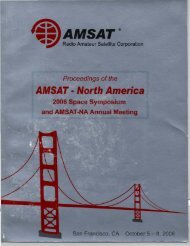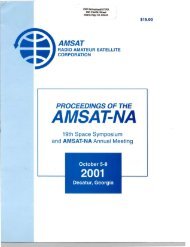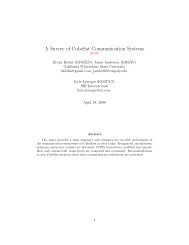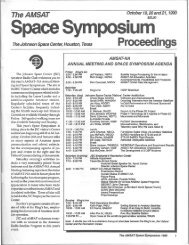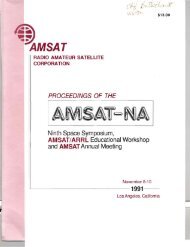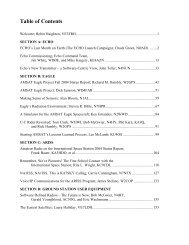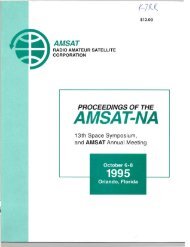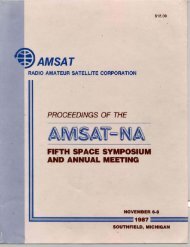October 27-29, 2000 - Klofas.com
October 27-29, 2000 - Klofas.com
October 27-29, 2000 - Klofas.com
You also want an ePaper? Increase the reach of your titles
YUMPU automatically turns print PDFs into web optimized ePapers that Google loves.
CubeSat: The Next Generation of Educational Picosatellites<br />
Prof. Jordi Puig-Suari, jpuigsua@calpoly.edu <br />
California Polytechnic State University <br />
San Luis Obispo, CA <br />
Prof. Robert Twiggs KE6QMD, Bob.Twiggs@Stanford.edu <br />
Stanford University <br />
Stanford, CA <br />
ABSTRACT<br />
A picosatellite called CubeSat is now under development by more than 20 groups of amateur radio enthusiasts<br />
and universities. This picosatellite that is a 4" cube and will weigh about lkg presents a real advantage for<br />
interested space enthusiasts in that it is significantly less expensive to build than micro or nano satellites and<br />
due to the small size and weight will be relatively inexpensive to launch into space. There is a technical<br />
challenge of building a useful satellite this small, but also political challenge of providing the frequency<br />
spectrum that would be required if hundreds of these CubeSats were launched using the amateur frequency<br />
bands. This paper will describe the international program of developers, the launch opportunities available for<br />
CubeSats, some of the issues with global operation of these satellites, some experiments planned for them and<br />
some proposals for sharing amateur frequency bands for educational purposes.<br />
1. Introduction<br />
2. CubeSat Development Program<br />
3. Participants in CubeSat Program<br />
4. Launch Opportunities<br />
5. Use of Amateur Frequency Considerations<br />
6. Conclusions<br />
7. Acknowledgements<br />
8. References<br />
TABLE OF CONTENTS<br />
1. INTRODUCTION<br />
The current trend in satellites to do more for less cost has led to the "Smaller, Cheaper, Faster, Better" space<br />
missions. It is generally resulting in many cases of doing things the same way as before in a somewhat smaller<br />
fonnat for less cost, but this has been cited as the basis for some ofNASA's recent deep space mission failures.<br />
To support some science missions and in proposing new missions, the trend is now to see what can be done by<br />
decreasing the spacecraft sizes by orders of magnitude. This is be<strong>com</strong>ing more practical with the rapid<br />
advances in decreasing electronics size, in greatly increased capability and very low power consumption. This<br />
decrease in size also directly benefits the mission cost in lower launch costs.<br />
There are several programs now exploring micro, nano and pico satellite sizes. These sizes ranging from<br />



